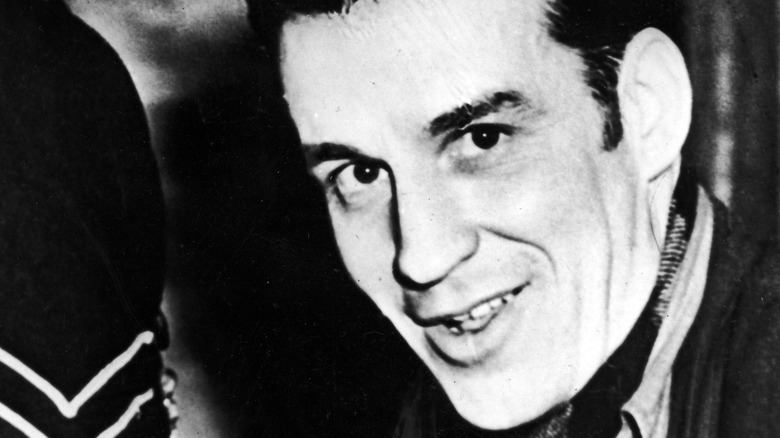Peter Manuel: The Scottish Serial Killer That Inspired A Portrayal Of Hannibal Lecter
The real-life horrors we encounter in everyday life are sometimes more terrifying than anything a writer can conceive on their own. Since the dawn of cinema's earliest days, filmmakers and screenwriters have routinely borrowed from popular myths and real-life human monsters to bring into the world some of the creepiest tales to ever play on the big screen. Robert Bloch's 1959 novel "Psycho" centered around a character modeled after the notorious Ed Gein, and was later turned into a horror film of the same name in 1960 (via Dark Echo). In 1931, German filmmaker Fritz Lang released "M," a thriller that was based on the crimes of serial murderer Peter Kurten (via The Chicago Tribune).
The 1991 film "The Silence of the Lambs" was a smash hit, earning more than $130 million at the box office (per Box Office Mojo). It was based on the 1988 novel by Thomas Harris, which served as a sequel to his best-seller "Red Dragon." "Red Dragon" was later made into a feature film as well, bringing back Sir Anthony Hopkins as Hannibal Lecter and Edward Norton as the FBI agent he gives assistance to. The film was released in 2002 (via IMDb), but was actually a remake of the film "Manhunter," a lower-budget movie that cast Brian Cox as the infamous cannibal psychiatrist (per IMDb).
Harris had his own inspiration for the character of Lecter. But when Brian Cox was given the part of the killer, he drew from an entirely different source.
Cox used a Scottish killer to prepare for his role of Hannibal Lecter
In an interview with Scroll In, Cox discussed who inspired him to play the part of Lecter. It might surprise some to discover that Cox looked to his childhood in Scotland where tales of serial killer Peter Manuel seemed to be on the tips of everyone's tongues. Manuel killed at least seven victims between 1956 and 1958 and was among the last convicts to be executed in the country before it abolished the death penalty in the 1960s (per The Glasgow Evening Times). Manuel fired his attorneys in the middle of the trial and defended himself in court. It was this bit of information that stood out to Cox.
Cox told the outlet "I was obsessed with him. He was this bogeyman for us, but he conducted his own defense. He was so rational and so apparently empathetic, but actually, there was no empathy, and that's how I saw Lecter. A man with a huge part of personality missing, who just cannot feel empathy for other people."
Cox served as the first of several actors to play Lecter, and was followed by Hopkins in "Silence of the Lambs," "Red Dragon," and "Hannibal." Gaspard Ulliel portrayed him in the 2007 film "Hannibal Rising," while Mads Mikkelsen conquered the role in the TV series "Hannibal" (via Movie Web).
Harris had another inspiration when creating the character. As he traveled south of the border for work, he made the acquaintance of an unusual character.
Thomas Harris based his character largely on a convicted murderer he met in a Mexican prison
Harris was working as a journalist in the 1960s when one of his stories led him to a prison in Mexico. There, he interviewed an injured inmate named Dykes Askew Simmons (via CBR). Harris struck up a conversation with a prison employee who was assisting Simmons and was in immediate awe of the man's mannerisms and level of intelligence. It would soon be revealed to Harris that this man was no prison employee. The man who was helping Simmons was none other than convicted serial killer Alfredo Ballí Treviño.
Trevino was a surgeon who was serving a prison sentence for murdering and cutting up his boyfriend after a heated dispute (via The International Business Times). CBR draws many similarities between Trevino and Lecter, especially Trevino's "impeccable taste and erudite mannerisms, even while imprisoned."
The outlet reports that Harris used other killers to help build the character of Lecter as well, though his experience with Trevino certainly did aid him in what was going on inside the head of a convicted killer. Arguably, it might not be the safest way to develop the subject of an author's writing, but it's definitely a way to get some real-life injected into your work.


